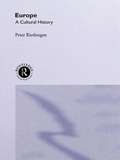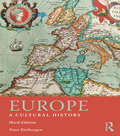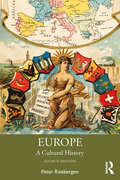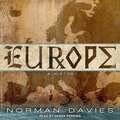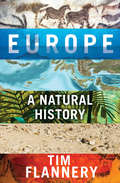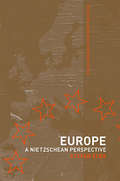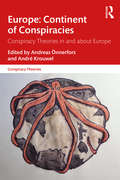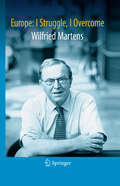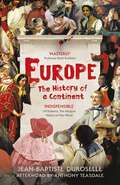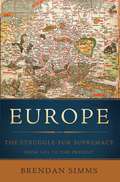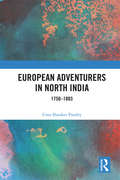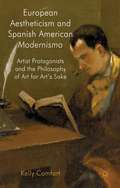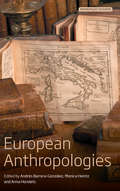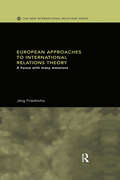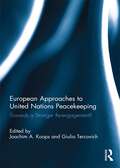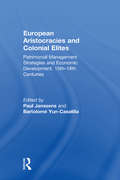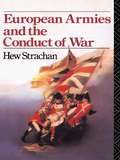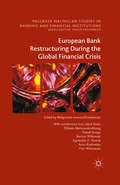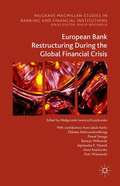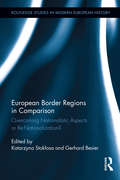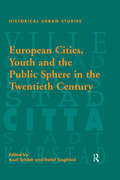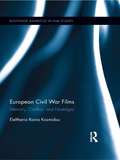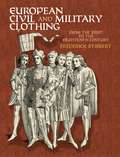- Table View
- List View
Europe: A Cultural History
by Peter RietbergenThis major contribution to the idea of Europe sweeps the continent from its Celtic and German origins through the influence of the Greeks and Romans to the fruitful -- and sometimes bloody -- contacts with other cultures. Peter Rietbergen portrays Europe's history as a series of four grand phases of continuity and change set in the context of political, social and economic developments. These phases are new forms of: surviving; believing; looking at man and the world; and consumption and communication. Rietbergen's descriptions are supported by a selection of illuminating excerpts such as: Chaucer's description of London in 1378; Michelangelo on Italian art; and popular music lyrics of Iron Maiden and Sting.
Europe: A Cultural History
by Peter RietbergenThis third, revised and augmented edition of Peter Rietbergen's highly acclaimed Europe: A Cultural History provides a major and original contribution to the study of Europe. From ancient Babylonian law codes to Pope Urban's call to crusade in 1095, and from Michelangelo on Italian art in 1538 to Sting's songs in the late twentieth century, the expressions of the culture that has developed in Europe are diverse and wide-ranging. This exceptional text expertly connects this variety, explaining them to the reader in a thorough and yet highly readable style. Presented chronologically, Europe: A Cultural History examines the many cultural building blocks of Europe, stressing their importance in the formation of the continent's ever-changing cultural identities. Starting with the beginnings of agricultural society and ending with the mass culture of the early twenty-first century, the book uses literature, art, science, technology and music to examine Europe's cultural history in terms of continuity and change. Rietbergen looks at how societies developed new ways of surviving, believing, consuming and communicating throughout the period. His book is distinctive in paying particular attention to the ways early Europe has been formed through the impact of a variety of cultures, from Celtic and German to Greek and Roman. The role of Christianity is stressed, but as a contested variable, as are the influences from, for example, Asia in the early modern period and from American culture and Islamic immigrants in more recent times. Since anxieties over Europe's future mount, this third edition text has been thoroughly revised for the late twentieth and early twenty-first centuries. Moreover, it now also includes a 'dossier' of some seventeen essay-like vignettes that highlight cultural phenomena said to be characteristic of Europe: social solidarity, capitalism, democracy and so forth. With a wide selection of illustrations, maps, excerpts of sources and even lyrics from contemporary songs to support the arguments, this book both serves the general reader as well as students of historical and cultural studies.
Europe: A Cultural History
by Peter RietbergenFully revised, updated and extended to include the momentous developments of 2020, this fourth edition of Peter Rietbergen's highly acclaimed Europe: A Cultural History is a major and original contribution to the study of Europe. The book examines the structures of culture in this part of Eurasia from the beginnings of human settlement on to the genesis of agricultural society, of greater polities, of urban systems, and the slow transitions that resulted in a (post-)industrial society and the individualistic mass culture of the present. Using both economic and socio-political analytical concepts, the volume outlines cultural continuity and change in Europe through the lenses of literature, the arts, science, technology and music, to show the continent’s ever-changing identities. In a highly readable style, it expertly contextualizes such diverse and wide-ranging topics as Celtic society, the Roman legal system, the oppositions between ‘elite’ and ‘popular’ culture in pre-industrial Europe, Michelangelo’s world-view, the interaction between the Enlightenment and Romanticism, the growth of a society of time and money, the appeal of fascism and other totalitarian ideologies, and the ways the songs of Sting express late twentieth-century thinking. Structured both chronologically and thematically, the text is distinctive in the attention consistently paid to the many ways Europe has been formed through its contacts with non-European cultures, especially those of Asia and the Americas. This edition concludes with an epilogue that discusses the ways Europe’s recent past – including the long-term efforts at further unification, and the various forms of opposition against it – has been both interpreted and misinterpreted; the importance of globalization; and the major challenges facing Europe in the present, amongst which are the consequences of the pandemic of 2020. With a wide selection of illustrations, maps, excerpts from primary sources and even lyrics from contemporary songs to support its arguments, the text remains the definitive cultural history of Europe for both the general reader and students of European history and culture.
Europe: A History
by Norman DaviesHere is a masterpiece of historical narrative that stretches from the Ice Age to the Atomic Age, as it tells the story of Europe, East and West. Norman Davies captures it all - the rise and fall of Rome, the sweeping invasions of Alaric and Atilla, the Norman Conquests, the Papal struggles for power, the Renaissance and the Reformation, the French Revolution and the Napoleonic Wars, Europe's rise to become the powerhouse of the world, and its eclipse in our own century, following two devastating World Wars. This is the first major history of Europe to give equal weight to both East and West, and it shines light on fascinating minority communities, from heretics and lepers to Gypsies, Jews, and Muslims. It also takes an innovative approach, combining traditional narrative with unique features that help bring history alive: 299 time capsules scattered through the narrative capture telling aspects of an era, and 12 snapshots offer a panoramic look at all of Europe at a particular moment in history. All told, Davies's Europe represents one of the most important and illuminating histories to be published in recent years.
Europe: A Natural History
by Tim FlanneryA tale of cave bears and comet strikes and a hundred million years of history by the bestselling author of Here on Earth: &“Marvelous.&”—Publishers Weekly (starred review) In Europe: A Natural History, world-renowned scientist, explorer, and conservationist Tim Flannery applies the eloquent interdisciplinary approach he used in his ecological histories of Australia and North America to the story of Europe. He begins 100 million years ago, when the continents of Asia, North America, and Africa interacted to create an island archipelago that would later become the Europe we know today. It was on these ancient tropical lands that the first distinctly European organisms evolved. Flannery teaches us about Europe&’s midwife toad, which has endured since the continent&’s beginning, while elephants, crocodiles, and giant sharks have come and gone. He explores the monumental changes wrought by the devastating comet strike and shows how rapid atmospheric shifts transformed the European archipelago into a single landmass during the Eocene. As the story moves through millions of years of evolutionary history, Flannery eventually turns to our own species, describing the immense impact humans had on the continent&’s flora and fauna—within 30,000 years of our arrival in Europe, the woolly rhino, the cave bear, and the giant elk, among others, would disappear completely. The story continues right up to the present, as Flannery describes Europe&’s leading role in wildlife restoration, and then looks ahead to ponder the continent&’s future: with advancements in gene editing technology, European scientists are working to recreate some of the continent&’s lost creatures, such as the great ox of Europe&’s primeval forests and even the woolly mammoth.
Europe: A Nietzschen Perspective (Routledge Advances in European Politics #Vol. 11)
by Stefan ElbeThere has been a deliberative, but as yet unsuccessful, attempt by scholars and policy makers to articulate a more meaningful idea of Europe, which would enhance the legitimacy of the European Union and provide the basis for a European identity. Using a detailed analysis of the writings of Nietzsche, Elbe seeks to address this problem and argues that Nietzsche's thinking about Europe can significantly illuminate our understanding. He demonstrates how Nietzsche's critique of nationalism and the notion of the 'good European' can assist contemporary scholars in the quest for a vision of Europe and a definition of what it means to be a European citizen.
Europe: Conspiracy Theories in and about Europe (Conspiracy Theories)
by dreas Önnerfors and André KrouwelThis edited volume investigates for the first time the impact of conspiracy theories upon the understanding of Europe as a geopolitical entity as well as an imagined political and cultural space. Focusing on recent developments, the individual chapters explore a range of conspiratorial positions related to Europe. In the current climate of fear and threat, new and old imaginaries of conspiracies such as Islamophobia and anti-Semitism have been mobilised. A dystopian or even apocalyptic image of Europe in terminal decline is evoked in Eastern European and particularly by Russian pro-Kremlin media, while the EU emerges as a screen upon which several narratives of conspiracy are projected trans-nationally, ranging from the Greek debt crisis to migration, Brexit and the COVID-19 pandemic. The methodological perspectives applied in this volume range from qualitative discourse and media analysis to quantitative social-psychological approaches, and there are a number of national and transnational case studies. This book will be of great interest to students and researchers of extremism, conspiracy theories and European politics.
Europe: I Struggle, I Overcome
by Wilfried MartensWilfried Martens - Europe: I Struggle, I Overcome Foreword by Angela Merkel Wilfried Martens has devoted his entire life to politics: as student leader, youth activist, President of the Flemish Christian Democrats, Prime Minister of Belgium, President of the European People's Party and European statesman. In his autobiography Martens offers the inside story on running a complex country like Belgium, fighting for European integration and unification, and transforming the European People's Party into a strong, united centre-right movement and leading European political family. Above all, this is a book about the intricacies of European politics and its guiding ideas, values and principles.
Europe: The Enlightening History of a Continent
by Jean Baptiste DuroselleWhether as an epic battleground or a cradle of civilizations, Europe has left an enduring imprint on the history of the world for over two millennia. From megalithic civilizations through ancient times, the Renaissance, the Industrial Revolution, the rise of nationalism, two world wars and the years that followed, this book looks beyond a series of distinct national histories to offer the history of Europe as an often shared experience across one continent. This book delves into events such as the fall of the Berlin Wall, traces the continents evolution from the collapse of Communism through the Iraq War, global financial crisis, Brexit and Russia's invasion of Ukraine. And then looking forward, it explores what would be necessary for the continent to remain a global power-player for years to come.
Europe: The Struggle for Supremacy, from 1453 to the Present (New Approaches To European History Ser. #19)
by Brendan SimmsIf there is a fundamental truth of geopolitics, it is this: whoever controls the core of Europe can control the entire continent, and whoever controls all of Europe can dominate the world. Over the past five centuries, a rotating cast of kings and conquerors, presidents and dictators have set their sights on the European heartland, desperate to seize this pivotal area or at least prevent it from falling into the wrong hands. From Charles V and Napoleon to Bismarck and Cromwell, from Hitler and Stalin to Roosevelt and Gorbachev, nearly all the key power players of modern history have staked their titanic visions on this vital swath of land.In Europe, prizewinning historian Brendan Simms presents an authoritative account of the past half-millennium of European history, demonstrating how the battle for mastery there has shaped the modern world. Beginning in 1453, when the collapse of the Byzantine Empire laid Europe open to Ottoman incursion and prompted the dramatic expansion of the Holy Roman Empire, Simms leads readers through the epic struggle for the heart of Europe. Stretching from the Low Countries through Germany and into the North Italian plain, this relatively compact zone has historically been the richest and most productive on earth. For hundreds of years, its crucial strategic importance stoked a seemingly unending series of conflicts, from the English Civil War to the French Revolution to the appalling world wars of the 20th century. But when Europe is in harmony, Simms shows, the entire world benefits--a lesson that current leaders would do well to remember.A bold and compelling work by a renowned scholar, Europe integrates religion, politics, military strategy, and international relations to show how history--and Western civilization itself--was forged in the crucible of Europe.
European Adventurers in North India: 1750–1803
by Uma Shanker PandeyThis book explores how European, particularly French, adventurers shaped early modern India. It highlights the significant contributions of these adventurers in social, political, economic, and intellectual life of north India in the 18th and the 19th centuries. The author examines how the French adventurers played a key role in bringing Western science and ideas to a polity in flux. He examines the role of individuals like René Madec, Sombre, De Boigne, Perron, Gentil, Canaple, Delamarr, Sonson, and Pedrose, who made instrumental contributions in modernising armies of pre-modern states in South Asia. The volume also underlines how French adventurers’ commercial networks developing from their enterprises opened up markets in the heartlands of north India for European consumers. Further, it brings to the fore intellectual pursuits of the leading French figures such as Anquetil Duperron, Polier, Gentil, De Boigne, and Perron, whose engagement with Indian literature opened a new chapter framing studies of the Occident. Rich in French, English, and translated Persian archival resources, this book will be of interest to scholars and researchers of colonial history, early modern history, military history, and South Asian studies.
European Aestheticism and Spanish American Modernismo
by Kelly ComfortEuropean Aestheticism and Spanish American Modernismo examines the changing role of art and the artist during the turn-of-the-century period and considers the multiple dichotomies of art and life, aesthetics and economics, production and consumption, and center and periphery. Through a comparative analysis of fictional works from Wilde, Huysmans, and Mann in the European context and Dario, Silva, Casal, and Gutierrez Najera in the Spanish American context, this transatlantic study locates a shared interest in the philosophy of 'art for art's sake' in both aestheticism and modernismo. The analysis of the aims and attitudes of different types of artist protagonists considers the intersection between the artist figure and the impressionistic and creative critic (chapters 1 and 2), the producers and consumers of art (chapters 3 and 4), and the aesthete, the dandy, and the flaneur (chapters 5 and 6). It also outlines the ways in which the artist figures avoid 'art for life's sake' (Part I), protest 'art for the market's sake' (Part II), or promote 'life for art's sake' (Part III). "
European Anthropologies
by Andrés Barrera-González Monica Heintz Anna HoroletsIn what ways did Europeans interact with the diversity of people they encountered on other continents in the context of colonial expansion, and with the peasant or ethnic 'Other' at home? How did anthropologists and ethnologists make sense of the mosaic of people and societies during the nineteenth and twentieth centuries, when their disciplines were progressively being established in academia? By assessing the diversity of European intellectual histories within sociocultural anthropology, this volume aims to sketch its intellectual and institutional portrait. It will be a useful reading for the students of anthropology, ethnology, history and philosophy of science, research and science policy makers.
European Approaches to International Relations Theory: A House with Many Mansions (New International Relations)
by Jörg FriedrichsA well-established community of American scholars has long dominated the discipline of international relations. Recently, however, certain strands of continental theorizing are being introduced into the mainstream. This is a critical examination of European approaches to international relations theory, suggesting practical ways of challenging manistream thought. Freidrichs presents a detailed sociological analysis of knowledge production in existing European IR communities, namely France, Italy and Scandinavia. He also discusses a selection of European schools and approaches.
European Approaches to United Nations Peacekeeping: Towards a stronger Re-engagement?
by Christian Breunig, Christine S. Lipsmeyer and Guy D. WhittenThis edited volume provides a comprehensive analysis of European approaches to United Nations peacekeeping by assessing past practice, present obstacles and future potentials related to nine core European countries’ contributions to blue helmet operations. By providing in-depth case studies on Denmark, France, Germany, Ireland, Italy, Norway, Sweden, The Netherlands and the United Kingdom, this book offers an evaluation of European approaches as well as a wide range of facilitating and constraining factors related to the above mentioned countries’ future involvement in UN peacekeeping. The book places particular emphasis on the recent involvement of European countries in the UN operation in Mali (MINUSMA) and explores to what extent this experience might lead to further marked increases of European supplies of troops and capabilities and thus a broader ‘European return’ to UN peacekeeping. Each chapter offers an up-to-date case study on key countries’ policies, challenges and opportunities for a stronger re-engagement in UN Peacekeeping It provides a comprehensive analysis of the main challenges and concrete ways ahead for overcoming institutional, political, financial and military obstacles (both at European capitals and within the UN system) on the path towards a stronger re-engagement of European troop contributing countries in the field of UN Peacekeeping. Furthermore, each chapter includes a set of policy-relevant recommendations for future ways ahead. The chapters in this book were originally published in International Peacekeeping.
European Aristocracies and Colonial Elites: Patrimonial Management Strategies and Economic Development, 15th–18th Centuries
by Bartolomé Yun-Casalilla Paul Janssens'Aristocracies', 'Old Regime colonial elites' - from Adam Smith to Karl Marx and beyond, scholars have discussed their role in the rise of the modern world, in economic development and capitalism. Generally speaking and with the exception of the English landlords, the verdict has been always negative. Furthermore, historians have usually viewed the Ancien régime aristocracies and colonial elites as social groups with entirely irrational or completely apathetic attitudes towards the management of their estates. This book constitutes the first attempt to analyse the question in a more critical and historical way. It takes a directly comparative approach, covering countries from Peru to Russia and from Naples to England in the early modern period and up to the end of the 18th century. The rationale of how these elites administered their patrimonies, its political, social and sometime moral dimensions, and the real effects of all this on economic development are considered here as key aspects for a better understanding of economic life. The result is a quite different picture in which economic history is also seen as the outcome of human actions in their own social and political context.
European Armies and the Conduct of War
by Hew StrachanDiscussing the key issues of modern warfare, Hew Strachan’s work examines the theory and practice of land warfare in Europe since 1700. Looking at warfare in the context of social and political change, Dr. Strachan interprets his subject matter as widely as possible, and European Armies and the Conduct of War considers the roles of air power and the impact of the United States on European military developments. Through the eyes of the major theorists of the day, European Armies examines: * how the social and political influences which shape armies, also mould the attitude of those armies to warfare* the story of techicnal innovation* the mounting pace of industrialization and its impact of warfare. Recent military history has tended to focus on the relationship between armies and society and there has been much original research on the subject of the conduct of war. This book brings these approaches together, providing information and insight vital to the study of this fascinating era.
European Bank Restructuring During the Global Financial Crisis (Palgrave Macmillan Studies in Banking and Financial Institutions)
by Jakub Kerlin Paweł Smaga Bartosz Witkowski Anna Kozłowska Elżbieta Malinowska-Misiąg Agnieszka K. Nowak Piotr WiśniewskiThis book explores the diversity of restructuring instruments applied to financial institutions in EU countries during the Global Financial Crisis. It investigates the cost of that support before evaluating its effects, as well as providing an extensive analysis of the measures undertaken. The first chapter presents a historical outline, discusses causes of crises, and offers an overview of the restructuring instruments and of how they were used for crisis management before 2007. The following chapters explore the financial environment in the EU before the crisis outbreak, the rescue actions and financial landscape after the events of the crisis. This book offers a critical and thorough analysis of the financial support provided to banks, providing case studies of over 95 banks from 17 EU member states. The authors provide an in-depth study of the pre and post-crisis landscape, and demonstrate that the crisis has by no means been overcome.
European Bank Restructuring During the Global Financial Crisis (Palgrave Macmillan Studies in Banking and Financial Institutions)
by Jakub Kerlin Małgorzata Iwanicz-Drozdowska Paweł Smaga Bartosz Witkowski Anna Kozłowska Elżbieta Malinowska-Misiąg Agnieszka Nowak Piotr WisniewskiThis book explores the diversity of restructuring instruments applied to financial institutions in EU countries during the Global Financial Crisis. It investigates the cost of that support before evaluating its effects, as well as providing an extensive analysis of the measures undertaken. The first chapter presents a historical outline, discusses causes of crises, and offers an overview of the restructuring instruments and of how they were used for crisis management before 2007. The following chapters explore the financial environment in the EU before the crisis outbreak, the rescue actions and financial landscape after the events of the crisis. This book offers a critical and thorough analysis of the financial support provided to banks, providing case studies of over 95 banks from 17 EU member states. The authors provide an in-depth study of the pre and post-crisis landscape, and demonstrate that the crisis has by no means been overcome.
European Border Regions in Comparison: Overcoming Nationalistic Aspects or Re-Nationalization? (Routledge Studies in Modern European History #21)
by Gerhard Besier Katarzyna StokłosaBorders exist in almost every sphere of life. Initially, borders were established in connection with kingdoms, regions, towns, villages and cities. With nation-building, they became important as a line separating two national states with different “national characteristics,” narratives and myths. The term “border” has a negative connotation for being a separating line, a warning signal not to cross a line between the allowed and the forbidden. The awareness of both mental and factual borders in manifold spheres of our life has made them a topic of consideration in almost all scholarly disciplines – history, geography, political science and many others. This book primarily incorporates an interdisciplinary and comparative approach. Historians, sociologists, anthropologists and political science scholars from a diverse range of European universities analyze historical as well as contemporary perceptions and perspectives concerning border regions – inside the EU, between EU and non-EU European countries, and between European and non-European countries.
European Cities, Youth and the Public Sphere in the Twentieth Century (Historical Urban Studies Series)
by Detlef SiegfriedThe late nineteenth century witnessed unprecedented levels of urban growth as migration swelled the population of European cities to new heights. The resulting problems of overcrowding and inadequate civic utilities prompted the governing elites to look for new planning solutions to address the needs of an increasingly urbanised society. At the same time young people were also increasingly recognised as being adversely affected, both politically and morally, by the on-going process of urbanization. Church groups, civic authorities, middle-class reformers and political movements all tried to steer youth toward their own concept of respectable behaviour, concepts that often tended to share many similarities in their paternalistic emphasis upon social discipline. This volume directly addresses the confluence of these issues, the point at which the city government, youth and public space meet and the resulting problems and tensions that were often created. Whether it be the corruption of the rural youth flooding into the cities at the beginning of the twentieth century, battles between Hitler Youth and working-class gangs in Nazi Germany, hooliganism in 1950s Hungary or the appropriation of, or withdrawal from, public spaces by youths in more recent times, all the chapters in this book explore ways in which authorities and adult groups have sought to control young people, both directly and indirectly. Drawing on a broad selection of methods and disciplines, a wide variety of case studies from across Europe are used to investigate the interactions between youth and authority, and show how these adapted and changed over time and in different countries. By taking a fresh look at these issues within a comparative framework, this volume furthers our understanding of modern European society during the twentieth century.
European Civil War Films: Memory, Conflict, and Nostalgia (Routledge Advances in Film Studies)
by Eleftheria Rania KosmidouThis book examines the ways in which late twentieth-century European cinema deals with the neglected subject of civil war. Exploring a range of films about the Spanish, Irish, former Yugoslavia, and Greek civil wars, this comparative and interdisciplinary study engages with contemporary debates in cultural memory and investigates the ways in which cinematic postmemory is problematic. Many of the films present an idealized past that glosses over the reality of these civil wars, at times producing a nostalgic discourse of loss and longing. Other films engage with the past in a melancholic fashion. These cinematic discourses articulate contemporary concerns, especially the loss of ideology and a utopian political horizon in the aftermath of the collapse of the Soviet bloc in 1989, a date that marks a significant break in European history and an accompanying paradigm shift in European cultural memory. Filmmakers examined include Trueba, Cuerda, Loach, Jordan, Kusturica, Dragojević, and Angelopoulos.
European Civil and Military Clothing: From The First To The Eighteenth Century (Dover Fashion and Costumes)
by Sir Frederic StibbertA wealthy Anglo-Italian connoisseur devoted to the nineteenth-century struggle for Italian unification, Frederick Stibbert amassed an extensive collection of arms, armor, and costume -- which today can be found in the Tuscan museum bearing his name. During the years in which he built up the museum's collection, he examined countless illuminated manuscripts, ancient documents, frescoes, paintings, and other records of armor and dress.The illustrations in this book, based on exceptional drawings by Stibbert himself and engraved by leading craftsmen of the day, reveal a remarkable panorama of European costume history. The volume contains 217 handsome plates depicting nearly 1,000 individual figures and their accessories, all scrupulously accurate and rendered in meticulous detail. Here are excellent illustrations of priests, warriors, Roman citizens, and women of ancient Britain; the German Emperor Otto and his wife; French monarchs and Scottish kings; jousting English knights of the thirteenth century; fifteenth-century Italian gentlewomen; elaborately coiffed ladies from the court of Versailles; and much more. Captions give the origins of the armor and dress, the sources of the drawings, precise descriptions of each item represented, and explanations of the function and manner of wearing armor.This extraordinary work has wide appeal: fashion historians will be attracted by its scrupulous accuracy and the authenticity of the garments; the royalty-free illustrations will be prized by artists and illustrators; and the handsome engravings and informative captions will entertain and instruct readers interested in the history of costume.
